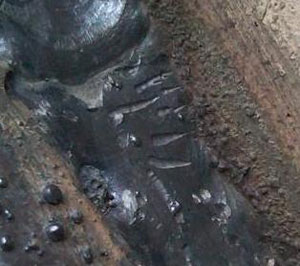Gas Marks on FCAW Process Welds
Q: I am welding with a flux-cored, gas-shielded wire (AWS classification E71T-1M). I notice that occasionally there will be curved lines or scratches on the surface of the weld. What are these and what causes them?
A: Gas marks are small grooves that sometimes appear on the surface of a weld made with the Flux-Cored Arc Welding process (FCAW), whether it is gas-shielded, flux-cored (FCAW-G) or self-shielded, flux-cored (FCAW-S) welding. Excessive levels of dissolved gases in the weld metal are the cause of gas marks. While these dissolved gases migrate out of or escape from the molten weld metal before it solidifies, some of the gases do not completely migrate through the molten slag before it solidifies. Thus, these remaining pockets of gas become trapped underneath the solid slag and leave indentations or gas marks on the weld surface. “Worm tracks” or “chicken tracks” are other common non-standard terms for gas marks. Gas marks are considered a cosmetic imperfection, rather than a weld defect.
Gas marks are more likely to occur with electrodes that produce a smaller weld puddle and have a faster freezing slag system, versus a large weld puddle with a slower freezing slag. Therefore, smaller diameter electrodes designed for all position welding (i.e. flat, horizontal, vertical and overhead) and run at lower current levels will be more susceptible to gas marks than larger diameter, flat and horizontal only position electrodes run at higher currents.

One potential cause of gas marks with the FCAW-S process is:
• Excessive arc voltage: As voltage increases, the arc length gets longer. If arc length is too long, excessive levels of nitrogen from the air are introduced into the arc (more than can be controlled or locked up with denitriders in the core elements). This extra nitrogen ends up in the molten weld metal, and then must escape.
Other potential causes of gas marks, with either gas-shielded or self-shielded, flux-cored welding are:
• Excessive moisture: If excessive moisture levels are in the arc, then that moisture can also end up in the molten metal as dissolved hydrogen, with some of it not escaping back through the slag before it solidifies, causing gas marks. The potential sources of moisture in the arc are:
a. From the air (high humidity).
b. From the plate surface (condensation and/or excessive hydrocarbon contaminants, such as rust, oil, primer, etc.).
c. From the wire (if wire packaging is damaged and/or wire is exposed to air for long periods of time, allowing condensation on the inner core elements to occur).
d. For gas-shielded electrodes, from the shielding gas (condensation in the cylinder. The dew point of shielding gases should be below -40°F (-40°C)).
• Contact tip to work distance (CTWD) too short: If the CTWD or electrical stickout (ESO) is too short for the particular electrode, moisture in the arc may not have enough time to completely burn off, resulting in excessive levels of dissolved hydrogen in the weld puddle. In addition, as CTWD gets shorter, arc length get longer, causing the same problem with FCAW-S electrodes as explained earlier.
• Welding procedures and/or techniques that result in an increased freezing rate of the slag. A more fluid weld puddle may stay fluid just long enough to allow all dissolved gases to escape before the slag freezes.
Note that if any of these issues became too excessive, the problem would go beyond gas marks (a cosmetic blemish only) and would cause porosity in the weld (a weld discontinuity and possible weld defect).
For gas-shielded electrodes, there is also a higher susceptibility to gas marks with argon (Ar) / carbon dioxide (CO2) blends (i.e. 75%Ar / 25% CO2) than with a 100% CO2 shielding gas. There is more of a spray arc type metal transfer with argon in the shielding gas, which results in a smaller metal droplet size, but also a greater number of droplets. The net effect is an increase in the total surface area of all molten droplets, resulting in a higher level of dissolved gases in the weld metal. This potential increases even more with higher percentage of argon in the gas mix than 75%. Note however, that most FCAW-G electrodes made today have very low diffusible hydrogen levels (i.e. H8 ratings or a maximum of 8 milliliters diffusible hydrogen per 100 grams weld metal). Some electrodes even have H4 ratings. Therefore, the likelihood of getting gas marks with either type of shielding gas has decreased in recent years.
